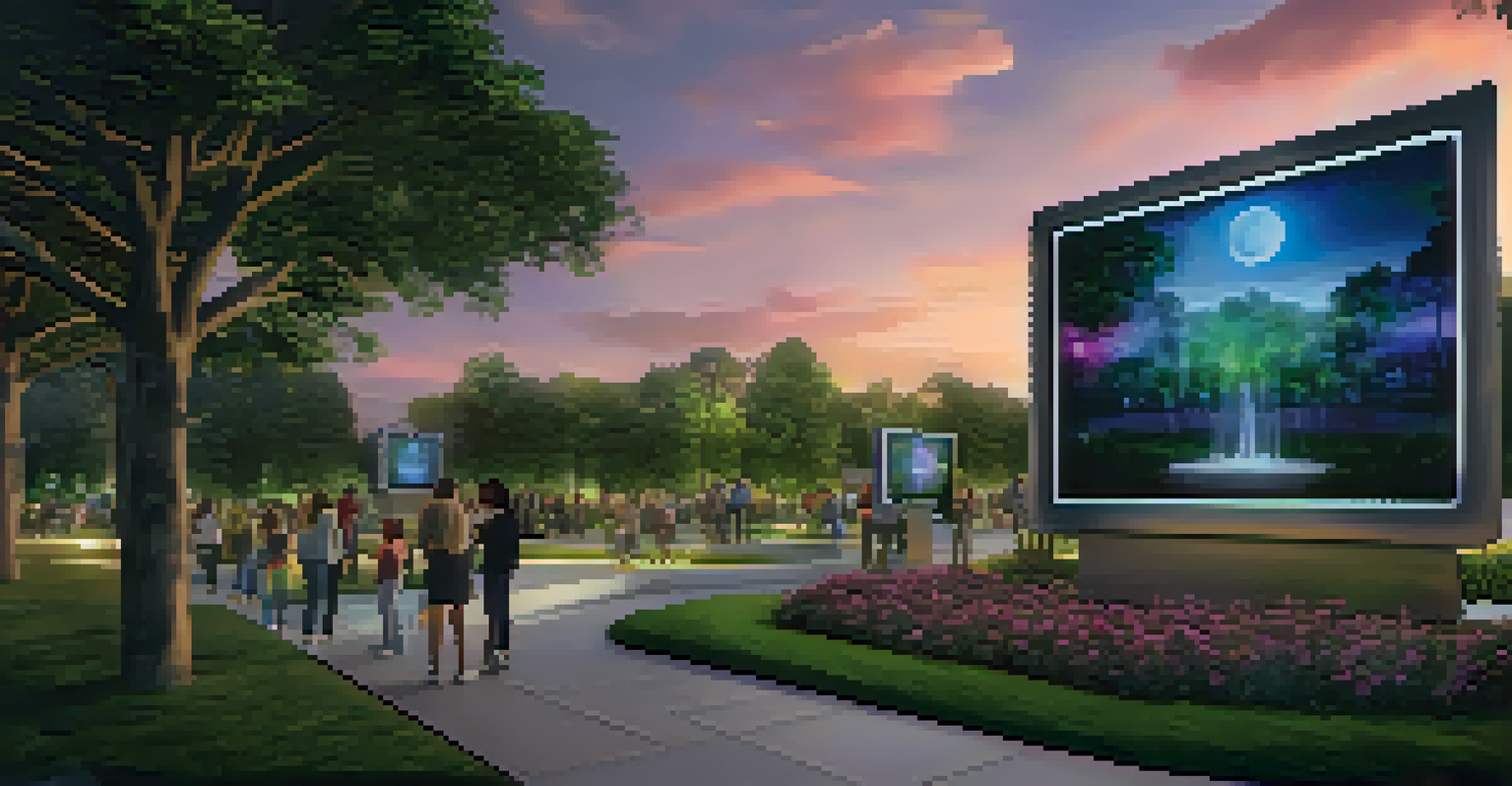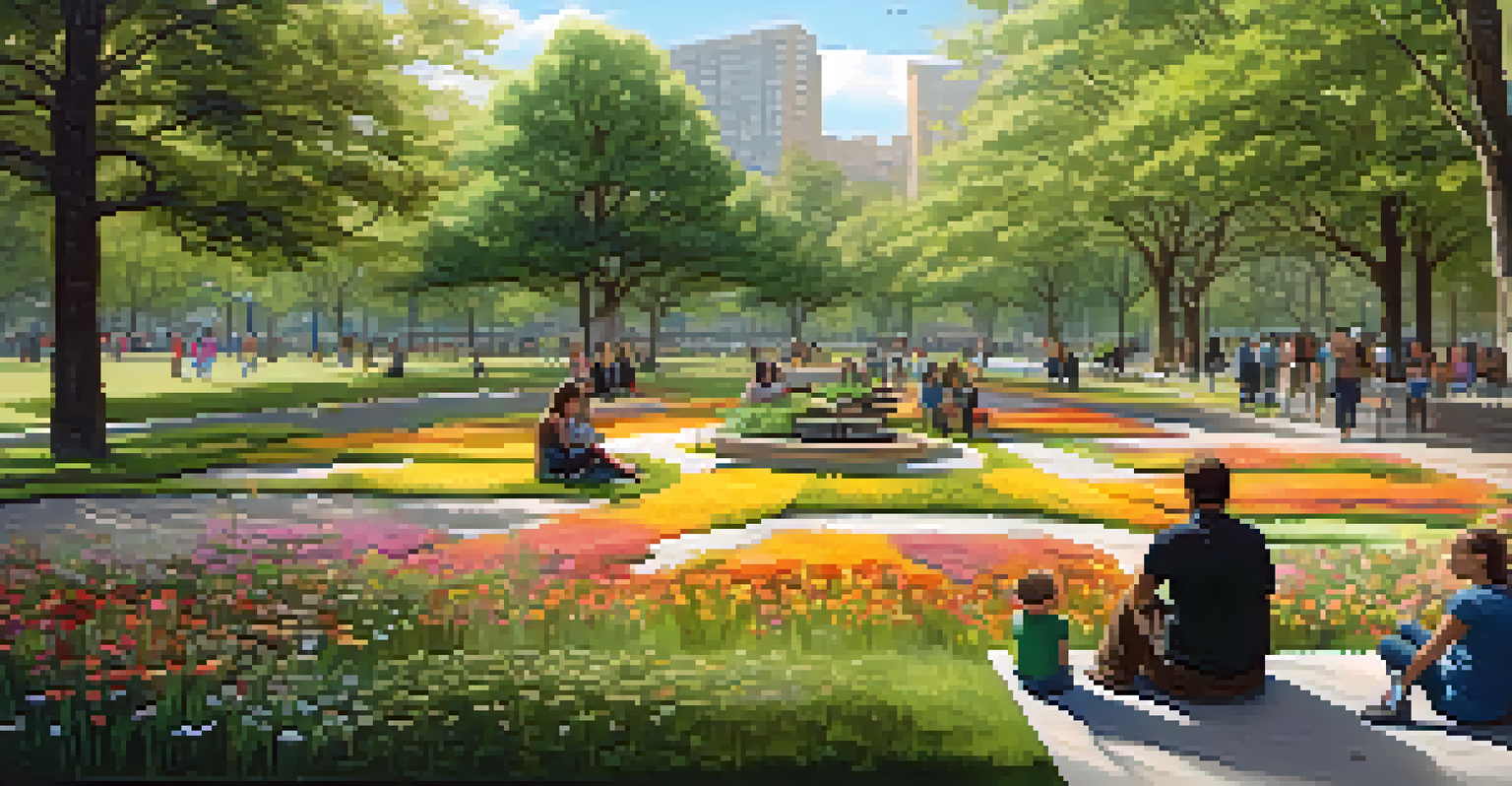The Evolution of Public Art Installations in Modern Cities

The Historical Roots of Public Art in Urban Spaces
Public art has been a part of human culture for centuries, often serving as a means of storytelling. From ancient sculptures in Greece to grand monuments in Rome, public art has historically celebrated significant events and figures. These installations were not just decorative; they played a role in community identity and pride, creating a sense of belonging among residents.
Public art is the bridge between the artist and the community, fostering dialogue and connection.
In the modern era, the approach to public art has expanded significantly. Rather than being confined to traditional forms, artists began experimenting with various mediums and messages. This shift reflects broader societal changes, including movements for civil rights and social justice, as artists sought to engage with contemporary issues through their work.
As cities evolved, so too did the purpose and presence of public art. What was once primarily focused on glorifying leaders or events transformed into a platform for dialogue and expression. This evolution paved the way for more interactive and thought-provoking installations that invite participation from the community.
The Rise of Street Art and Graffiti Culture
Street art emerged as a powerful form of public expression in the late 20th century, often associated with urban youth culture. Unlike traditional public art, which was typically sanctioned and commissioned, street art is often created spontaneously in response to social issues and personal experiences. This raw and unfiltered approach resonated with many, capturing the spirit of the streets.

Graffiti artists like Banksy and Shepard Fairey have brought attention to the potential of street art to challenge societal norms. Their work often comments on political and social issues, encouraging passersby to think critically. This movement has transformed the perception of public art, elevating it from vandalism to a respected form of artistic expression.
Public Art: A Voice for Change
Public art increasingly serves as a catalyst for social change, addressing critical issues such as climate change and racial inequality.
As cities began to embrace street art, they also recognized its capacity to revitalize neighborhoods. Murals and installations can attract tourism and foster community engagement, showing that public art can contribute to economic growth while also sparking conversations on important topics.
Interactive Installations: Engaging the Community
Modern public art has increasingly focused on interactivity, inviting viewers to participate in the experience. Installations such as the 'Before I Die' wall encourage community members to share their aspirations, turning the artwork into a living document of collective hopes. This engagement fosters a sense of ownership and connection among residents.
Art is not what you see, but what you make others see.
Moreover, technology has played a significant role in enhancing these interactive experiences. Augmented reality and digital installations allow viewers to engage with art in ways that were previously unimaginable. This blend of art and technology not only captivates audiences but also encourages them to think critically about their surroundings.
By transforming passive observers into active participants, interactive installations make art more relatable and accessible. This shift in approach aligns with the modern ethos of inclusivity, ensuring that public art resonates with a diverse audience and reflects the community's values.
Public Art as a Tool for Social Change
Public art has increasingly taken on the role of a catalyst for social change, reflecting the zeitgeist of the times. Artists are using their platforms to address pressing issues such as climate change, racial inequality, and mental health awareness. This art often aims to provoke thought and inspire action among viewers.
For instance, installations like the 'Fearless Girl' statue have sparked widespread discussions about gender equality and women's empowerment. By placing art in public spaces, these messages reach a broader audience, transcending the walls of galleries and museums. The visibility of such works amplifies their impact and encourages community dialogue.
Technology Transforms Public Art
The integration of technology, such as digital projections and interactive installations, revolutionizes public art, making it more engaging and accessible.
As cities grapple with complex social challenges, public art serves as a reminder of the power of creativity in advocating for change. This evolution highlights the potential of art to unite communities and inspire collective action, proving that public installations can be more than just aesthetic objects.
The Role of Technology in Modern Public Art
Technology has revolutionized the landscape of public art, allowing for innovative forms of expression that were once unimaginable. Digital projections, light shows, and interactive screens are now common elements in urban installations. These technological advancements not only enhance visual experiences but also attract a younger, tech-savvy audience.
One example is the use of projection mapping, which turns buildings into dynamic canvases that tell stories or convey social messages. This technique creates a captivating experience that transforms familiar spaces into engaging art displays. As a result, public art can reach audiences in ways that traditional mediums cannot.
Moreover, social media has amplified the visibility of public art. Artists can share their work instantly with a global audience, fostering connections and encouraging collaboration. This digital presence not only promotes the artists themselves but also helps build community around public installations, making art accessible and relevant to a wider audience.
Global Perspectives: Public Art Around the World
Public art varies significantly across different cultures and geographic regions, reflecting local histories and values. In cities like Berlin, murals commemorate the struggles of the past, while in Brazil, vibrant street art celebrates cultural heritage and community resilience. These diverse expressions enrich the global tapestry of public art.
Moreover, art festivals around the world, such as the Venice Biennale and the public art projects in Melbourne, showcase the international dialogue on public art. Artists from various backgrounds come together to share their perspectives, fostering a sense of global community. This exchange of ideas enhances the understanding of how public art can influence urban living.
Global Diversity in Public Art
Public art reflects diverse cultural histories and values around the world, enriching urban environments with a variety of artistic expressions.
As cities become more interconnected, the sharing of public art practices encourages innovation and experimentation. By learning from each other's successes and challenges, cities can adapt their approaches to public art, ensuring that it remains relevant and impactful in a rapidly changing world.
The Future of Public Art in Urban Environments
Looking ahead, the future of public art is poised for exciting changes, especially with the incorporation of sustainability practices. Artists are increasingly focused on eco-friendly materials and themes that highlight the importance of preserving our environment. This shift not only aligns public art with global sustainability goals but also resonates with the values of younger generations.
Additionally, as cities continue to grow and evolve, public art will likely play a crucial role in enhancing urban identity. Communities will seek to express their unique stories and cultures through art, making public spaces more inviting and reflective of local heritage. This evolution emphasizes the need for collaboration between artists, local governments, and community members.

Ultimately, the future of public art lies in its ability to adapt and respond to the changing dynamics of urban life. As cities become more diverse and interconnected, public art will continue to serve as a vital tool for engagement, expression, and social change, ensuring that it remains relevant in the hearts and minds of the communities it serves.